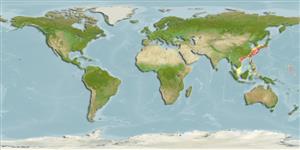Common names from other countries
Teleostei (teleosts) >
Acanthuriformes (Surgeonfishes) >
Pomacanthidae (Angelfishes)
Etymology: Genicanthus: Greek, geny, -yos = face, jaw + Greek, akantha = thorn (Ref. 45335).
Environment: milieu / climate zone / depth range / distribution range
Ecology
Marine; reef-associated; non-migratory; depth range 15 - 100 m (Ref. 9710). Tropical
Western Pacific: southern Japan to Taiwan and northern Philippines.
Size / Weight / Age
Maturity: Lm ? range ? - ? cm
Max length : 21.0 cm TL male/unsexed; (Ref. 4858)
Inhabits seaward rocky and coral reefs (Ref. 9710). Hardy aquarium species; takes standard food such as chopped beef, freeze-dried shrimp, mysids, etc. A protogynous hermaphrodite (Ref. 55367). Forms permanent harem groups composed of a single male and several smaller females (Ref. 55367).
Life cycle and mating behavior
Maturity | Reproduction | Spawning | Eggs | Fecundity | Larvae
A monandric species (Ref. 55367). Sex change occurs at 9.3 cm TL (Ref. 55367). Forms permanent harem groups composed of a single male and several smaller females (Ref. 55367). Also Ref. 103751.
Allen, G.R., 1985. Butterfly and angelfishes of the world. Vol. 2. 3rd edit. in English. Mergus Publishers, Melle, Germany. (Ref. 4858)
IUCN Red List Status (Ref. 130435)
CITES (Ref. 128078)
Not Evaluated
Threat to humans
Harmless
Human uses
Aquarium: commercial
More information
ReferencesAquacultureAquaculture profileStrainsGeneticsElectrophoresesHeritabilityDiseasesProcessingMass conversion
Tools
Special reports
Download XML
Internet sources
Estimates based on models
Preferred temperature (Ref.
115969): 21.9 - 27.7, mean 24.3 (based on 24 cells).
Phylogenetic diversity index (Ref.
82804): PD
50 = 0.5010 [Uniqueness, from 0.5 = low to 2.0 = high].
Bayesian length-weight: a=0.03090 (0.01359 - 0.07026), b=2.89 (2.70 - 3.08), in cm Total Length, based on LWR estimates for this (Sub)family-body shape (Ref.
93245).
Trophic level (Ref.
69278): 3.4 ±0.45 se; based on food items.
Resilience (Ref.
120179): Medium, minimum population doubling time 1.4 - 4.4 years (Preliminary K or Fecundity.).
Fishing Vulnerability (Ref.
59153): Low vulnerability (11 of 100).
